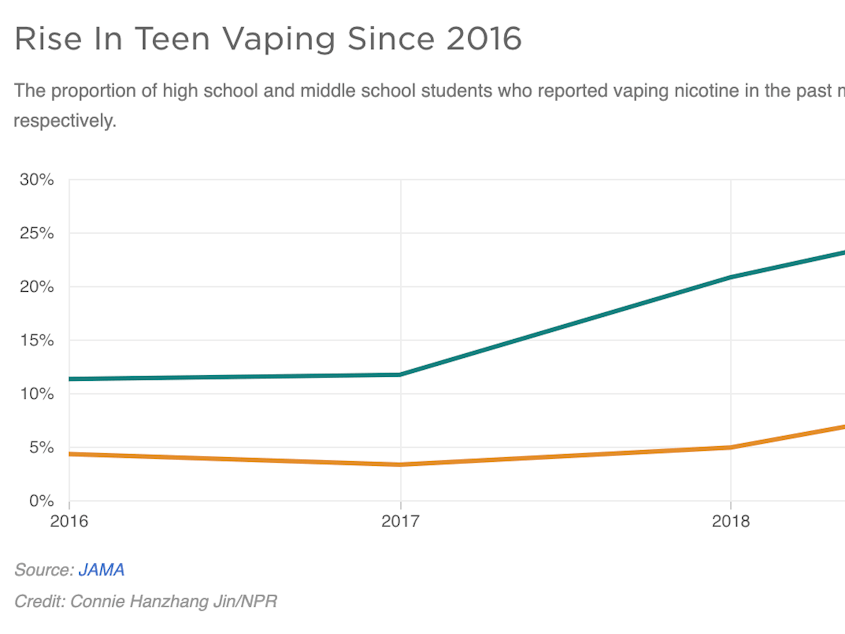More Teens Than Ever Are Vaping. Here's What We Know About Their Habits

Three years ago, only about one in ten high school students reported having recently used e-cigarettes. But a study published this week in JAMA shows the proportion of students vaping nicotine has now grown to more than one in four.
Researchers from the Food and Drug Administration and Centers for Disease Control and Prevention analyzed data from the 2019 National Youth Tobacco Survey, which is conducted annually. They drilled down on e-cigarette use among high school and middle school students based on data from 19,000 students in the eighth, tenth and twelfth grades.
Teen nicotine vaping has become so prevalent in recent years that the Food and Drug Administration has called it an "epidemic." An estimated 5.3 million teens use e-cigarettes, according to the study.
It is illegal in all states for people under 18 to purchase e-cigarettes, and some states have raised that age to 21. Despite this and recent efforts to crack down on retailers selling to youth, rates of teen vaping have continued to rise.
"For young people, this is of particular concern," the study's authors wrote, "because it could promote ... nicotine dependence, making it easier to initiate and proceed to regular e-cigarette use or transition to cigarette or other combustible tobacco product use."
Sponsored
Students who took the survey, however, didn't appear to have moved on to traditional cigarettes yet. Just 6% of high schoolers reported having smoked a cigarette in the last month — a decrease from last year's survey.
The researchers estimate nearly 1 million students use e-cigarettes daily. This includes about one in 17 high schoolers nationwide.
In an effort to lower rates of teen vaping, the FDA is considering banning most flavors. The e-cigarette giant Juul stopped selling some of its flavors last month. It has continued to sell tobacco, menthol and mint flavors.
Because the students surveyed were asked questions in spring of 2019, the study showed how students used e-cigarettes before Juul's ban. As it turns out, the discontinued flavors weren't high schooler students first choice.
Among high schooler students, more than half said they mostly used flavors that are still being sold. Of those, mint was by far the most popular.
Sponsored
The mango flavor, which Juul has stopped producing, was most popular among middle schoolers, though mint was a close second.
The company did not respond to a request for comment on the results of the JAMA study.
The study did not examine flavors other manufacturers produce, which can range from cinnamon toast to cotton candy. It also did not ask specifically about vaping THC, a chemical found in marijuana.
Juul is the most popular e-cigarette used by U.S. teenagers — the term "juuling" has become synonymous with the use of e-cigarettes — but it's not the only one.
Forty percent of high school students who used e-cigarettes tended to use a different brand, or had no usual brand at all. And that number could be even higher, the researchers say, since some students may falsely believe that other e-cigarettes are also made by Juul. [Copyright 2019 NPR]



